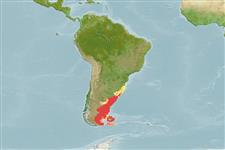>
Scombriformes (Mackerels) >
Stromateidae (Butterfishes)
Etymology: Stromateus: Greek, stromatos = a fish flattened body with a lot of colours (Stromateus sp.) (Ref. 45335).
More on author: Fowler.
Environment: milieu / climate zone / depth range / distribution range
Ökologie
seewasser benthopelagisch; tiefenbereich 22 - 133 m (Ref. 36453), usually ? - 100 m (Ref. 36453). Subtropical; 26°S - 55°S, 69°W - 48°W
Southwest Atlantic: southern Brazil to Tierra del Fuego, Argentina.
Size / Gewicht / Alter
Maturity: Lm ? range ? - ? cm
Max length : 38.0 cm NG Männchen/unbestimmt; (Ref. 36453)
Rückenflossenstacheln (insgesamt) : 0; Rückenflossenweichstrahlen (insgesamt) : 47 - 56; Afterflossenstacheln: 0; Afterflossenweichstrahlen: 40 - 48; Wirbelzahl: 43 - 46. Body blue green dorsally, silvery white ventrally. Many round dark blue spots on upper half of body. Distal parts of fins darker (Ref. 27363).
Spawns near the coast (Ref. 36453). Juveniles lives in close association with jellyfishes (Ref. 36453).
Life cycle and mating behavior
Geschlechtsreife | Fortpflanzung | Ablaichen | Eier | Fecundity | Larven
Menni, R.C., R.A. Ringuelet and R.H. Aramburu, 1984. Peces marinos de la Argentina y Uruguay. Editorial Hemisferio Sur S.A. Buenos, Aires, Argentina. 359 p. (Ref. 2806)
IUCN Rote Liste Status (Ref. 130435: Version 2024-2)
Bedrohung für Menschen
Harmless
Nutzung durch Menschen
Fischereien: nicht kommerziell
Tools
Zusatzinformationen
Download XML
Internet Quellen
Estimates based on models
Preferred temperature (Ref.
123201): 5.6 - 14.6, mean 8.5 °C (based on 224 cells).
Phylogenetic diversity index (Ref.
82804): PD
50 = 0.6250 [Uniqueness, from 0.5 = low to 2.0 = high].
Bayesian length-weight: a=0.00891 (0.00509 - 0.01560), b=3.17 (3.01 - 3.33), in cm total length, based on LWR estimates for this species & (Sub)family-body (Ref.
93245).
Trophic level (Ref.
69278): 3.3 ±0.38 se; based on food items.
Widerstandsfähigkeit (Ref.
120179): hoch, Verdopplung der Population dauert weniger als 15 Monate. (Preliminary K or Fecundity.).
Fishing Vulnerability (Ref.
59153): Moderate vulnerability (36 of 100).
Nutrients (Ref.
124155): Calcium = 71.8 [31.7, 143.6] mg/100g; Iron = 1.03 [0.50, 1.87] mg/100g; Protein = 15.7 [13.8, 18.3] %; Omega3 = 0.368 [0.232, 0.576] g/100g; Selenium = 33.8 [18.4, 67.8] μg/100g; VitaminA = 21.1 [7.8, 56.4] μg/100g; Zinc = 0.79 [0.55, 1.12] mg/100g (wet weight); based on
nutrient studies.
